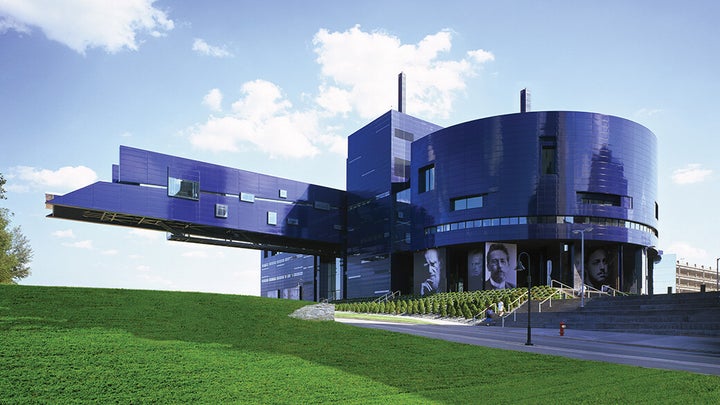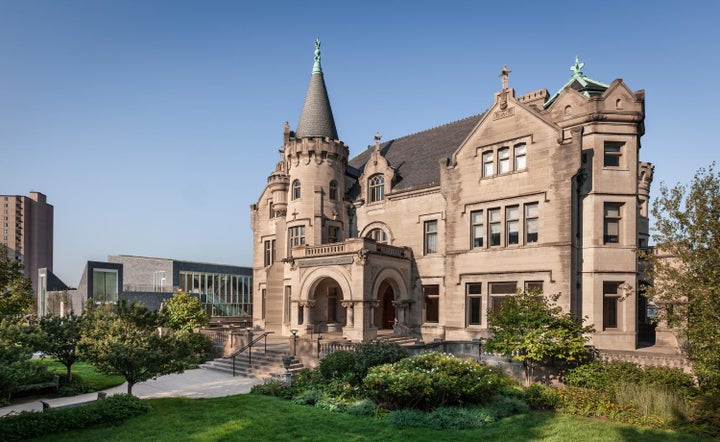
Minneapolis and St. Paul may be called Twin Cities populated by Minnesotans, but each has its own character. As a casual visitor last month it was not something I had time to discern on my own, but inquiries of the natives suggested that the latter is more laid back than the former, whose population is 100,000 larger. What was easy to see is that Minneapolis is on a building boom along its broad avenues, quickly filling up with scores of nearly identical glass condos. As one local said, “St. Paul is the last city of the East and Minneapolis is the first city of the West.”

Whether or not you’re actually attending the Super Bowl LII—whose current average ticket price is $4,320—which as of this writing still hasn’t come down to the final two teams, winter becomes Minneapolis in the ways only American cities settled by Scandinavians and Germans can. For while the excitement builds around the Super Bowl, the lead-up is a festival week called the annual Great Northern (above) from January 26 to February 4. Its boosters believe it’s a good way to beat the cold the locals are used to. As people in the Southwest insist that 110 degrees isn’t all that terrible because it’s dry heat, Minnesotans insist once the temperature drops below zero, any further drop really isn’t all that noticeable. Sponsored by Target, which is headquartered in Minneapolis, the Great Northern, which includes the Saint Paul Winter Carnival (January 25-February 10), whose events include the Rice Park Ice Carving competition and a Pioneer Press Treasure Hunt.
The Great Northern will host the U.S. Pond Hockey Championships on Lake Nokomis, which is as expressive of the city’s winter character as is the City of Lakes Loppet Ski festival, which includes an ice pyramid, fire dancers, and an enchanted forest, and the Columbia Sportswear Skate Marathon that snakes 26 miles through the icebound city. And what would a winter festival be without a fast and furious curling exhibition at the Frogtown Curling Club?
Food events will dot the Twin Cities, including a Saint Paul’s Chef’s Experience, an outdoor feast held by the restaurants Saint Dinette and Corner Table and Revival at the Saint Paul's Farmer's Market in Lowertown. The Surly Brewing Co. will also hold an outdoor party with music and a bonfire.
At any time of the year Minneapolis has a remarkable array of cultural activities and institutions, most strikingly the Minneapolis Institute of Art, spread over eight acres. With nearly 90,00 artworks the Institute’s departments include Africa and the Americas; Chinese and Southeast Asia; Japanese and Korean, Photography; Contemporary Art; Decorative Textiles, and 900 European and American paintings from the 14th century to the present.

The Walker Art Center of contemporary art, founded in 1940, has now greatly expanded to a new building designed by Swiss architects Jacques Herzog and Pierre Meuron made of aluminum mesh panels and a connecting glass hallway, with the restoration two years ago of the outdoor Sculpture Garden set on what was once marshland. From now until March 18, Adiós Utopia: Dreams and Deceptions in Cuban Art Since 1950 looks at 65 years of revolutionary Cuban art (above) through more than 100 works of painting, graphic design, photography, video, installation, and performance created by more than 50 Cuban artists and designers. Nothing of this breadth and depth has been shown in the U.S. since 1944, when the Museum of Modern Art in New York presented Modern Cuban Painters.

Since 1963 the Guthrie Theater (above) has been one of America’s most respected venues for repertory performing arts, cast in the spirit of founder Sir Tyrone Guthrie (who passed away in 1971), who envisioned regional theater as a Midwestern alternative to the brash, ever-more commercial character of Broadway.
Hamlet was its first production, when the Guthrie was only a summer theater. Since then the Theater has gone through artistic, managerial and financial troughs, but it had a resurgence in the 1970s and became nearly self-sufficient by the end of the decade. No longer a repertory theater, by 2000 the organization had outgrown itself and a new Theater (right) was to be built at a cost of $125 million on the banks of the Mississippi River on the east side of downtown, debuting in June, 2006, reviving Tyrone Guthrie’s original belief that “The river itself was what most charmed and amazed us. . . . Eventually the Twin Cities will realize that their river can be, and ought to be, a wonderful life-giving amenity.”
One of the best things about the new Theater is that anyone can visit it throughout the day without attending a performance, walking through its vast spaces and up the fourth level “Endless Bridge” that overlooks St. Anthony Falls.

I certainly would not miss a visit to the beautiful American Swedish Institute (above), located in the former Turnblad Mansion attached to the modern Nelson Cultural Center. The mansion, which has been rightly compared with the Gardner Museum in Boston and the Frick in New York, was built by Swan Turnblad, publisher of Svenska Amerikanska Posten, the largest Swedish language newspaper in the U.S.; he and his family lived in the house until 1929, when he donated it to what is now called the American Swedish Institute. The mansion’s interior was done in exquisite woodwork, with eleven Swedish tile stoves. Dining rooms and bedrooms look much the way they were, but the grandeur of it never spills over into ostentation, which would be an affront to Swedes.
The Cultural Center includes more than 7,000 museum objects that express the best of contemporary Swedish culture and the history of immigrants who settled Minnesota, whose DNA can readily be seen in the faces of the people who work in or visit the Center. There is also a café inside called FIKA, after the Swedish term for a coffee break, serving specialties like Swedish meatballs ($12), gravlax ($12), smörgasår open-faced sandwiches ($13), and lingonberry rice pudding ($8).

Far smaller and much more modest is the city’s Somali Museum of Minnesota (above), which is not easy to find but well worth ferreting out. Located in the basement of a bodega, the small space was founded by Osman Mohammed Ali, a local entrepreneur proud of his African heritage and of the contributions of 25,000 Somalians who have made Minnesota their home and run more than 600 businesses in the Twin Cities. With more than 700 pieces, the museum is ever growing, including nomadic artwork and a thatched hut with a weaving rack and numerous examples of the colorful woven fabrics indigenous to Somalia.
The Museum was clearly a labor of love by Ali, but I do hope you meet the remarkable young curator named Sarah Larsson—her name is clearly of Swedish heritage—whose love and dedication to the Museum is palpable. Trained as an anthropologist and community advocate, with an M.A. from Yale University, Sarah is also a touring folk singer of Eastern European song. It is rare to meet someone of her background, intelligence and sheer exuberance anywhere, but to meet her in Minneapolis is to find just how international this splendid Midwestern city has become. As for the Super Bowl (as I write this the Vikings still have a very good chance to make it) whatever the weather will be outside, the insipidly named U.S. Bank Stadium will be all warm and toasty owing to a translucent ceiling that somehow keeps the heat in. Say the words "state of the art" and you might as well be saying modern NFL football stadium. Mineapolis's is only a year old--only Atlanta's is newer--and if God were a football fan this is what he'd build, with seats for 66,625 people, 26 food service operations, its own sports art collection, huge well-stocked sky boxes, and exterior glass walls the size of a hangar that slide effortlessly open to let in the fans. A guided tour takes 90 minutes, proving that there is nothing bigger than football, no matter how cold it gets in America.
Photo credits: Great Northern: courtesy of BLT WLF Photography; Walker Art Center: courtesy of Walker Art Center; Guthrie Theater: courtesy of Meet Minneapolis Convention and Visitors Association; American Swedish Institute: courtesy of American Swedish Institute; Somali Museum: courtesy of Somali Museum; US Bank Stadium: courtesy of US Bank Stadium.
